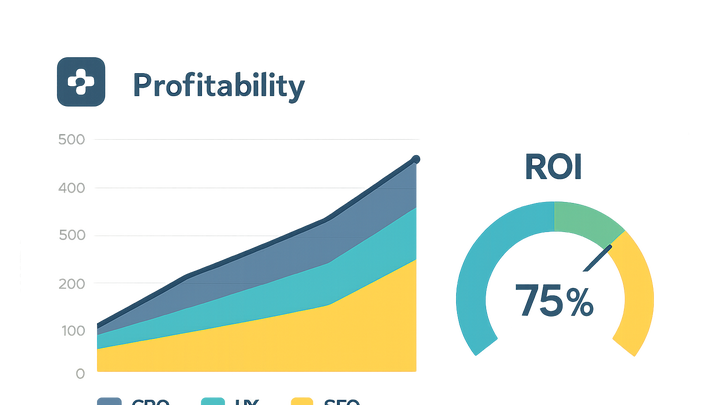Published on 2025-06-29T19:24:21Z
What is Return on Investment (ROI)? Examples for CRO, UX, and SEO
Return on Investment (ROI) is a financial metric that evaluates the efficiency of an investment by comparing net gains to the associated costs.
In the context of website optimization—spanning CRO, UX, and SEO—ROI helps teams prioritize initiatives that deliver the greatest revenue or lead-generation impact.
By calculating ROI, stakeholders can justify budgets, benchmark performance, and steer continuous improvements across digital channels.
Tools like Prevue.me offer actionable critiques, making it easier to estimate potential revenue uplift from design tweaks, SEO enhancements, and accessibility fixes.
Monitoring ROI over time ensures that optimization strategies remain aligned with business objectives and adapt to evolving user behavior.
A clear understanding of ROI empowers cross-functional teams to make data-driven decisions, reduce wasted effort, and focus on high-impact changes.
Return on investment (roi)
ROI measures investment efficiency by comparing net gains to costs, guiding prioritization in CRO, UX, and SEO optimization.
Understanding ROI in Digital Optimization
Return on Investment (ROI) quantifies the profitability of improvements in CRO, UX, and SEO. It helps teams decide which initiatives drive the most value relative to cost.
-
Roi formula
The standard ROI formula is:
ROI = (Net Gain from Investment - Cost of Investment) / Cost of Investment × 100%.- Net gain:
The increase in revenue, leads, or conversions attributable to the optimization effort.
- Investment cost:
All expenses related to the optimization effort, including tool subscriptions like prevue.me, design labor, and development costs.
- Net gain:
-
Interpreting roi
Positive ROI indicates net profit; negative ROI signals a loss. Zero ROI means break-even. Higher percentages reflect more efficient resource use.
Why ROI Matters for CRO, UX, and SEO
ROI aligns digital optimization efforts with business goals, ensuring budget is spent on high-impact changes. It fosters data-driven decision-making across teams.
-
Budget justification
Marketers and designers can demonstrate the value of optimization projects by presenting clear ROI projections to stakeholders.
-
Performance benchmarking
Comparing ROI across different campaigns or design changes highlights what works best for your audience.
-
Continuous improvement
Tracking ROI over time allows for iterative enhancements, focusing on strategies that deliver sustained growth.
Measuring ROI with Prevue.me
prevue.me streamlines ROI calculation by providing actionable critiques for maximum lead generation, SEO health, UX enhancements, and accessibility compliance.
-
Actionable cro insights
prevue.me evaluates conversion funnels and suggests optimizations that can drive measurable revenue gains.
- Funnel analysis:
Identify drop-off points and calculate potential revenue lift.
- A/b test recommendations:
Prioritized test ideas based on projected ROI.
- Funnel analysis:
-
Lead generation & seo evaluation
Combines lead-gen optimization with SEO audits to estimate traffic growth and its revenue impact.
- Keyword impact:
Estimate value of organic traffic for target keywords.
- Form optimization:
Forecast lead volume increase from improved form UX.
- Keyword impact:
-
Ux & accessibility reviews
Spotlights usability and accessibility fixes that enhance user satisfaction and reduce churn.
- Usability fixes:
Quantify revenue gain by improving key user flows.
- Accessibility compliance:
Assess cost savings from avoiding legal risks and improving inclusivity.
- Usability fixes:
Best Practices to Maximize ROI
Adopting a systematic approach to optimization ensures sustainable ROI growth across CRO, UX, and SEO initiatives.
-
Data-driven hypotheses
Base experiments on quantitative and qualitative research to ensure high-impact changes.
-
Prioritization frameworks
Use ICE or PIE scoring models to rank experiments by potential ROI.
-
Iterative testing
Continuously test, measure, and refine to compound ROI gains over time.
-
Cross-functional collaboration
Ensure alignment between marketing, design, and development teams to reduce costs and accelerate implementation.
